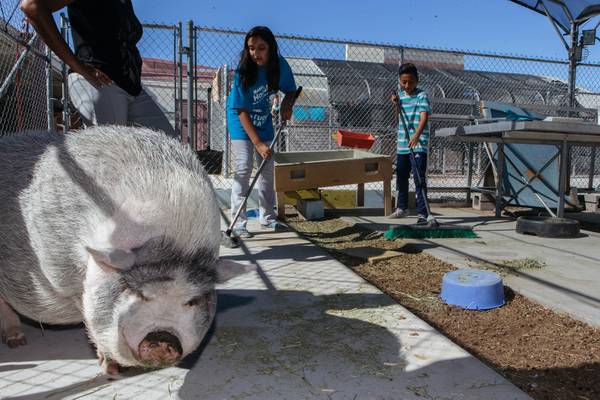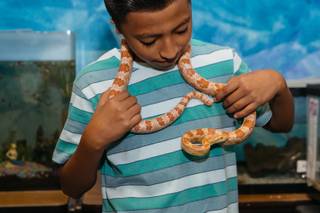Paola grabs a fistful of hay and sets it down in front of a 200-pound potbelly pig, who promptly gobbles it up off a concrete slab in a fenced-off part of a Las Vegas school courtyard.
Paola, a fifth-grader at Mabel Hoggard Elementary School, then proceeds to sweep the hay left over by Sammy, and the three goats that also roam through the 500-square-foot pen, into a dirt area where it will decompose or be eaten later.
A six-year student of the elementary school, which starts in kindergarten and lasts through fifth-grade, Paola considers Sammy “a friend” and has studied everything from his genetic formation to how to handle and care for him. It’s part of a life sciences program offered by the school that includes 42 species and more than 130 animals for students to help raise.
“He’s big and friendly,” Paola said of Sammy. “But he has taught me a lot too.”
Life sciences teacher Kimberly Law helped start an animal program more than 10 years ago with a couple of snakes, which were offered as a way for students to gain a hands-on, real-life study of the subject. Her class, which she began teaching full-time in 2012, has since expanded to include an “animal lab” classroom with exotic birds, reptiles and rodents, as well as a farm outside with desert tortoises, ducks, chickens and other animals.
Clubs before school and during the lunch hour allow students additional time with their adopted friends, where they learn such topics as animal care and animal genealogy.
Hoggard students work their way up from learning about different families of animals in first and second grade to feeding and exercising the animals, as well as cleaning their habitats, by the time they’re fifth-graders. In addition to raising and caring for the animals, Law saves money by breeding chinchillas, sugar gliders and geckos for local pet store Exotic Pets in exchange for store credit. She also earns more than $1,000 in local grants each year to help cover a portion of veterinary costs and food supplies.
“We wanted to give our kids a more involved experience,” Law said. “I think this is a unique way for them to learn, and something no other elementary kids get to do.”
Miguel, another fifth-grader, held a white Pekin duck on a recent Monday as he recalled how Mango, a 3-year-old sun conure bird and student favorite, spent a few weeks at his house this year. Miguel is one of dozens of students to have taken home a Hoggard animal during one of the school’s breaks.
Seeing the animals on a regular basis and caring for them “is just fun,” Miguel said, adding it was a step up from a different school he previously attended.
“We didn’t have any animals there,” Miguel said. “Here we have a lot.”
Law said as many as 25 of the animals are taken home over winter break and summer each year. The rest she cares for herself, working over school breaks and weekends to maintain what she calls a “labor of love.” Law, a Chicago native and mother of seven, began at the elementary school in the early 2000s as a campus monitor and became a long-term substitute in the years that followed. Hoggard’s animal lab and farm came to life when Law was granted her request to teach life sciences full-time.
Beyond class, the project has expanded to the clubs “Zookeepers” and “Green Thumb Kids” during the school’s lunch hour. Both clubs feature 25 to 50 students on any given weekday, Law said. Without a major accredited zoo in Las Vegas, having such programs at school is “that much more important,” she said.
Among students at the afternoon club, third-grader Phoebe held a crested gecko to her chest in the animal lab before carefully placing it back in its glass-cased habitat. She said she had never seen the animal, nor heard of it before starting school at Hoggard.
“They’re not scary once you get used to them,” Phoebe said.
Although some bites, allergic reactions and dropped animals have posed setbacks for the program, such incidents are relatively uncommon thanks to protocols for keeping both students and animals safe, Law said.
Students are required to sit on the ground when handling smaller animals that could be injured if dropped, Law said, and no animals — even the snakes — are large enough to significantly injure a student. The Clark County School District requires a series of waivers and paperwork for parents to sign before their kids interact with the animals, and the school is required to alert officials and parents in the event of any animal bites.
For any snake bites, even those that don’t break the skin, the school is required by the district to call 9-1-1.
“We have a lot of patience and care because we know they’re young and they’re learning,” Law said. “At the same time, we want to put them in a position to know what they’re doing before they start handling the animals.”
While interacting with the school’s animals can be therapeutic, the primary function of the animals is to serve as an education tool for students interested in future zoology, veterinary or even other life sciences fields such a geology. The project also includes a garden with several plants grown via aquaponics, a system that recirculates water from a fish tank to nurture the soil of a vegetable grow bed.
Law said the “jury is still out” on whether the program will inspire future professionals in animal care and research, as even her oldest former students with experience in Hoggard’s animal lab and farm are still in high school.
Among the additions she hopes to make in the next year include the acquisition of an alpaca — because llamas “spit too much,” Law says — and solar panels to power lights in the animals’ cages at night. It’s all part of a goal to promote a more “off the grid” and organic way to farm and care for animals.
“We’ll never be fully off the grid, of course, because we’re an elementary school,” Law said. “But we’re going to keep getting bigger and offering more for our students.”



Join the Discussion:
Check this out for a full explanation of our conversion to the LiveFyre commenting system and instructions on how to sign up for an account.
Full comments policy